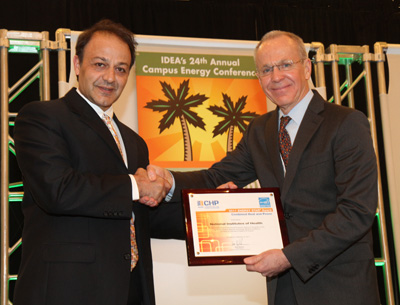
Dr. Farhad Memarzadeh, Director, Division Technical Resources, Office of Research Facilities, receiving a 2011 ENERGY STAR® CHP Award on behalf of the National Institutes of Health from Gary McNeil, U.S. EPA Combined Heat and Power Partnership, Climate Protection Partnerships Division at the IDEA conference in Miami, Florida.
On February 23, 2011, the U.S. Environmental Protection Agency (EPA) recognized the National Institutes of Health as one of three facilities with the Energy Star Combined Heat and Power (CHP) award for simultaneously producing electricity and useful thermal energy from a single energy source, such as natural gas, biomass, coal, or waste heat. “Cogeneration” technology leads to energy savings and reductions in greenhouse gas emissions and other air pollutants, helping to protect the health of Americans.
NIH’s Cogeneration is one of the CLEANEST ever built in the world with an average 10 Parts per Million (PPM) of Nitrogen Oxides (NOx) emission without any scrubber or water/steam injection.
How do you meet the escalating energy needs of one of the world’s largest medical research facilities that is growing, constrained for space, under pressure to minimize air pollution and challenged by a tight construction budget? The National Institutes of Health (NIH) answered that question in 2002 when it began operation of a natural gas-fired CHP system. Cogeneration energy savings is 640 billion BTUs a year (the equivalent of the energy used in about 5,000 homes in a year).
Located near the center of its 75-building, 300-acre main campus in Bethesda, Maryland, the CHP system — designed and developed by PEPCO Energy Services — generates up to 23 MW of electricity for the local grid. By using otherwise-wasted heat from the exhaust of the combustion turbine, it also produces up to 180,000 pounds per hour of steam that is used to provide space heating, space cooling and to support laboratory operations. Cogeneration will save NIH an estimated $4 Million each year in steam and electricity costs
With an operating efficiency of 76 percent, the CHP system requires approximately 31 percent less fuel than a typical energy-supply system. (For comparison, the efficiency of separate production of electricity and thermal energy is typically less than 50 percent.) Based on this comparison, the CHP system prevents an estimated 51,400 tons of CO2 emissions annually, equivalent to the emissions of more than 8,900 passenger vehicles.
The EPA CHP Partnership, established in 2001, is a voluntary program that encourages the use of CHP to reduce the environmental impact of power generation. The partnership works closely with energy users, the CHP industry, state and local governments, and other energy stakeholders to facilitate the development of new projects and to promote energy, environmental and economic benefits.
For more information about the CHP Partnership, visit: http://www.epa.gov/chp .
.
For more information about the CHP awards, visit: http://epa.gov/chp/public-recognition/current_winners.html